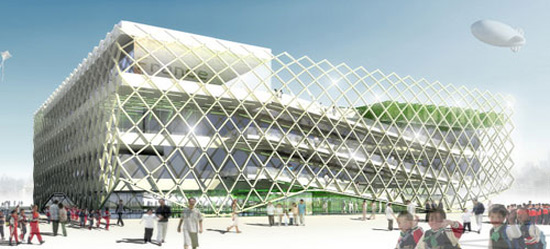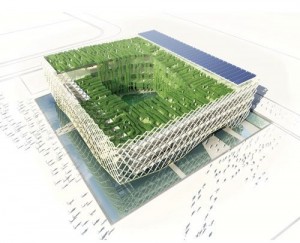Shanghai Expo 2010: The French Pavilion
 The 2010 World Exposition in Shanghai will be the first registered one in a developing country. Officially known as “Expo Shanghai 2010,” it will last 184 days and provide China an opportunity to show off its remarkable economic growth. The expo will also give foreign nations and companies a chance to further develop business partnerships with China and Chinese companies. This is the fourth in an ongoing series that will look at the upcoming expo, from country pavilions to trade development. In this article, we take a look at the French Pavilion.
The 2010 World Exposition in Shanghai will be the first registered one in a developing country. Officially known as “Expo Shanghai 2010,” it will last 184 days and provide China an opportunity to show off its remarkable economic growth. The expo will also give foreign nations and companies a chance to further develop business partnerships with China and Chinese companies. This is the fourth in an ongoing series that will look at the upcoming expo, from country pavilions to trade development. In this article, we take a look at the French Pavilion.
By Guillaume Denis
SHANGHAI, Aug. 10 – France was the first country to accept China’s invitation to join the World Expo 2010 and because of that was able to secure a good location for its site. It was also the first country to begin the construction of its pavilion called “Sensual City.”
The design for the pavilion was the winning entry chosen by French authorities and will be 6,000 square meters big. Despite the pavilion’s seemingly simple design, the budget allocated for the structure amounts to RMB552 million.
With that budget, it is “the highest among all participants” says Mr. Xu Bo, director of the International Participation Department of the Bureau of World Expo Coordination. According to French president Mr. Nicolas Sarkozy, the pavilion will present, “France’s contribution in the sustainable urban development for one of the biggest economic metropolises in the planet.”
 The pavilion will be built using the most advanced materials and environmental protection technology; serving as a model of energy efficiency and recycling techniques.
The pavilion will be built using the most advanced materials and environmental protection technology; serving as a model of energy efficiency and recycling techniques.
The French Consul General in Shanghai declared during its garden party event during French National Day that the pavilion represents the friendship between the two countries. Authorities created the French Company for the 2010 Shanghai Expo or the COFRES SAS to handle the construction of the pavilion.
This group will coordinate initiatives for France and China and is headed by its president José Frèches and the General Commissioner for the French section, Alain Vauthier.
Partner companies and public groups associated in the conception of the French Pavilion will be working with the COFRES’ Board of Directors and its thematic commissions.
France-China diplomatic relations go back to 1964 when then French president, General Charles De Gaulle, recognized the sovereignty of the People’s Republic of China and was the first country in the West to do so.
This fact is the reason why France and China have always had a unique relationship. Thirty years later, the two countries also signed a global strategic partnership that lead to a strengthening of their cultural, economic and diplomatic ties.
 This October, the French Consulate General in Shanghai will celebrate its 30 year anniversary just as the People’s Republic of China will also commemorate its 60 year anniversary. This symbolizes the longevity of diplomatic relations between the two countries.
This October, the French Consulate General in Shanghai will celebrate its 30 year anniversary just as the People’s Republic of China will also commemorate its 60 year anniversary. This symbolizes the longevity of diplomatic relations between the two countries.
Diplomatic relations between the two started to deteriorate in April 2008 when pro-Tibet demonstrations occurred during the Olympic Torch relay in Paris.
In December 2008, Hu Jintao decided not to go to France during his trip in Europe after Nicolas Sarkozy met the Dalai Lama in Poland. The reason this relationship went sour is simply because the Chinese authorities have always considered France as an ally or even as a friend since the recognition of the People’s Republic of China more than 30 years ago.
The relationship only started to improve when France and China both issued a statement on April 1st, wherein France testified that the its government reaffirms opposition to Tibetan independence.
Since the event, the China-France relationship is back to normal but even then the quarrel does not seem far from over. It is harder for Chinese citizens to get a visa to France. There was a lot of criticism over visa restrictions during the Beijing Olympics, but the French visa policy has been hardened as well.
In the first seven months of 2007, France already imported €15.4 billion of goods from China while France only exported €5 billion. This gap is forecast to be even bigger in the coming years.
France also invests a lot in China. According to the French Embassy in China, more than 850 French companies created 1,880 facilities. Their turnover also reached €20 billion in 2006, twice more than the French direct exports, while the turnover have a 20 to 25 percent increase a year.
France is active in Wuhan, where investments represent more than 60 percent of the European investments in the city and 13 percent of the FDI worth US$2.13 billion. Twenty five percent of French investments in China are made in this city and most of them cover the automobile industry, energy exploitation and communication.
On the other hand, more than half of the French investments in China focus on Shanghai, according to the French Consul General, Thierry Mathou.
 Chinese investments in France are also increasing but are nothing in comparison to French investments in China. In 2006, the Chinese investments in France were worth about US$4.97 million and Chinese contractual investments in France reached US$120 million. For the moment, the Chinese companies are investing in numerous activity sectors such as chemistry, apartment decoration, electronics and electronic goods.
Chinese investments in France are also increasing but are nothing in comparison to French investments in China. In 2006, the Chinese investments in France were worth about US$4.97 million and Chinese contractual investments in France reached US$120 million. For the moment, the Chinese companies are investing in numerous activity sectors such as chemistry, apartment decoration, electronics and electronic goods.
The France-China relationship is not only based on economics, but on culture as well. According to the French Minister of National Education, there are now about 16,ooo Chinese students in France attending university and graduate school. While French students in China 50,000 in 2007, according to the French Embassy in China.
Further Reading
The complete Shanghai Expo 2010 series
- Previous Article China Remembered: The Jianguo Hotel Gets a Fax Machine
- Next Article Training Costs May Be Paid by Employees









